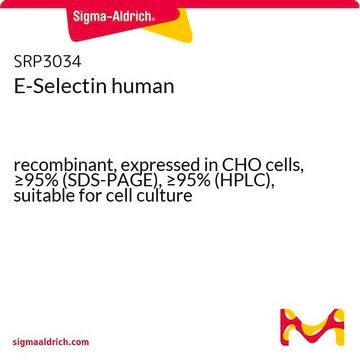S9555
Anti-E-Selectin (CD62E) antibody, Mouse monoclonal
clone 1.2B6, purified from hybridoma cell culture
Synonym(s):
Monoclonal Anti-CD62E, Anti-E-Selectin, Anti-ELAM-1
About This Item
Recommended Products
biological source
mouse
conjugate
unconjugated
antibody form
purified immunoglobulin
antibody product type
primary antibodies
clone
1.2B6, monoclonal
form
buffered aqueous solution
mol wt
antigen 100-115 kDa
species reactivity
human, pig
concentration
~2 mg/mL
technique(s)
capture ELISA: suitable
flow cytometry: suitable
immunohistochemistry (frozen sections): suitable
immunoprecipitation (IP): suitable
indirect ELISA: suitable
indirect immunofluorescence: 1-2 μg/mL using using 293-T cells transfected with E-selectin fusion protein
western blot: suitable (non-reduced)
isotype
IgG1
UniProt accession no.
shipped in
dry ice
storage temp.
−20°C
target post-translational modification
unmodified
Gene Information
human ... SELE(6401)
Looking for similar products? Visit Product Comparison Guide
General description
It is a 140KDa protein mainly expressed in endothelial cells. E- selectin is characterized with an N-terminal domain, epidermal growth factor (EGF)-like domain, lectin (ligand-binding) domain, variable short consensus repeats and transmembrane domain.
Specificity
Immunogen
Application
Biochem/physiol Actions
Target description
Physical form
Storage and Stability
Disclaimer
Not finding the right product?
Try our Product Selector Tool.
Storage Class Code
10 - Combustible liquids
WGK
WGK 3
Flash Point(F)
Not applicable
Flash Point(C)
Not applicable
Certificates of Analysis (COA)
Search for Certificates of Analysis (COA) by entering the products Lot/Batch Number. Lot and Batch Numbers can be found on a product’s label following the words ‘Lot’ or ‘Batch’.
Already Own This Product?
Find documentation for the products that you have recently purchased in the Document Library.
Our team of scientists has experience in all areas of research including Life Science, Material Science, Chemical Synthesis, Chromatography, Analytical and many others.
Contact Technical Service







